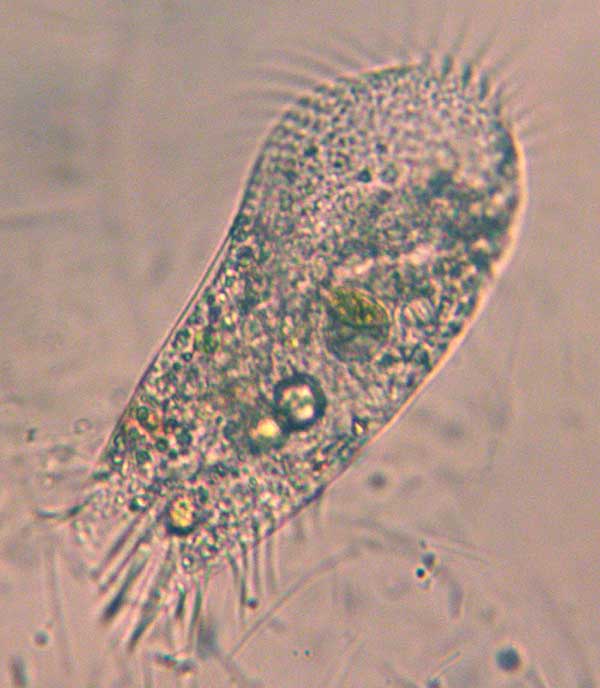Excerpts from Jim Conrad's
Naturalist Newsletter

from the January 27, 2013 Newsletter issued from the valley of the Dry Frio River in northern Uvalde County, southwestern Texas, on the southern border of the Edwards Plateau; elevation ~1750m (~5750 ft); N29.62°, W99.86°; USA
STYLONYCHIA As spring comes on, water from the little Dry Frio River behind the cabin grows more and more populated with microscopic organisms, and my safaris through drops of river water become more interesting. This week's drop was animated with footprint-shaped, hyperactively fast-moving little beings that zipped across the microscope's field of vision with such velocity that I didn't even try to photograph one... until one turned up boxed inside a square pen formed by overlapping filaments of Spirogyra alga. Around and around he went trying to escape his Spirogyra cage until finally the brainless little creature seemed to pause to think, and I snapped the above picture.
In school we studied the famous Paramecium and I recall how it moved through water with the help of tiny hairs, or cilia, scattered across its body, and it was somewhat similarly shaped, and inside its body it contained similar bubble-like affairs which we were taught were food vacuoles. But Paramecium was a little more slender than what's in the picture, plus its cilia were evenly spread over the body's surface, while the hairs on our little being appear to be clustered at the ends and, unlike the even-lengthed hairs of Paramecium, of different lengths. Still, I figured that what I had was a member of the protozoan Class Ciliatea, a unicellular Ciliate, like Paramecium, so that was the starting point of my identification attempt.
With a bit of Internet browsing it became clear that here we had a member of the genus STYLONYCHIA.
Stylonychia species are carnivorous and prey mostly on other protozoans and bacteria. When starved, they turn to cannibalism. Learning this, and seeing how fast they dart through the water, I began thinking of them as top predators in my jungly drop of water, like juiced-up Bobcats on a scrubby hillside with lots of rabbit warrens.
Cilia on the body surface of Stylonychia sweeps food into an "oral groove" leading into its body through a "mouth pore" that ends in the gullet, at the bottom of which a sort of bubble forms with the food inside. This bubble with food inside becomes a food vacuole like those seen in our picture. As food vacuoles wander through the body of Stylonychia, organelles called lysosomes fuse with the vacuoles, emptying digestive enzymes into them. The enzymes break down the food into small pieces, which can then pass through the pores of the vacuole membrane as the vacuole travels through the cell supplying food to different parts of the cell body.
Cilia on Stylonychia not only sweep food into the body, but also -- unlike cilia on Paramecium -- they can be used like legs to move the body with a walking motion. In fact, our picture fairly matches one on the internet where the observer interpreted his Stylonychia as walking upside-down across the undersurface of his microscope slide's coverglass.
Stylonychia are described as very common inhabitant of ponds. I think the one in our picture is about 150 microns in length, a bit longer than the width of an average human's hair.